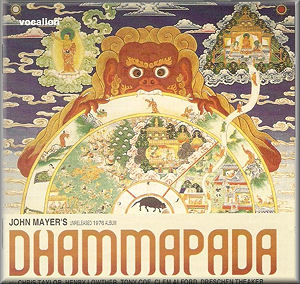- Maha-Samana (Mayer)
- Sannyasin (Mayer)
- Yamabushi (Mayer)
- Sannyasin two (Mayer)
- Bhikkhu (Mayer)
- Sannyasin three (Mayer)
- Tri-Dandin (Mayer)
- Chakka (Mayer)
Chris Taylor (flute)
Henry Lowther (trumpet)
Tony Coe (sax, clarinet)
Clem Alford (sitar)
Dreschen Theaker (tabla)
Neil Coton (Sarod, Tanpura)
John Leach (Koto, Cheng)
Zack Laurence (piano)
Toni Campo (bass)
Harold Fisher (drums)
Tristan Fry, Gary Kettel, Terence Emery (percussion)
rec.1976
The remarkable thing about this important work of John Mayer's is that, though commissioned in 1976, it lay languishing in the vaults for three decades. It was only with this Vocalion release in 2006 that one could hear how Mayer's vision tallied with the auditory results.
Dhammapada is a suite of eight movements. Unusually this was not an Indo-Jazz concept but one predicated on the development of Buddhism `from India through to China, Korea and Japan', as Jonathan Mayer makes clear in his elucidatory booklet notes. Longish movements alternate with brief ones, creating a sense of return and bringing narrative development to the project. The opening is by far the longest part of the work, and it coalesces textures that are to come, presenting them through bell chimes, and a fluid associative interplay of ideas and tonalities. The Chinese and Japanese elements are explored before a more straight-ahead jazz component emerges via Henry Lowther's commanding trumpet playing and Tony Coe's urgent solo, all the while riding above rolling flurries and eddies from the percussion. The colouristic patterns add textural variety, the ensemble allowing, for instance, flautist Chris Taylor to unravel a busy solo over propulsive bass and colouristic support.
Yamabushi features the koto solo of John Leach - rolled refinement. Around the three minute mark an infectious ostinato is set up that sweeps us to the end of the movement - these rolling ostinati are a compelling feature of Mayer's writing. Following this Japanese movement we find a Chinese one in Bhikkhu. Here March patterns and militaristic calls infiltrate the writing; calls to arms flurries and plenty of portent but also a brisk clarity to the writing too which is never clotted as a result. Contrapuntal mastery is never far away either, nor - here - rock and hard bop figures, as well as hints of baroque influences in Lowther's trumpet passage. The up-tempo dance of Sannyasin Three - 35 seconds of it - prefaces the slow sitar playing in Tri-Dandin, before incremental excitement is generated and ensemble colour broadens. The finale is Chakka which ends, after vigorous and buoyant magnetism, in a modish fade out.
It ends an album in which inter-relatedness and variety ensure a rewarding listening experience. How good that this work has now seen the light of day.
Jonathan Woolf
